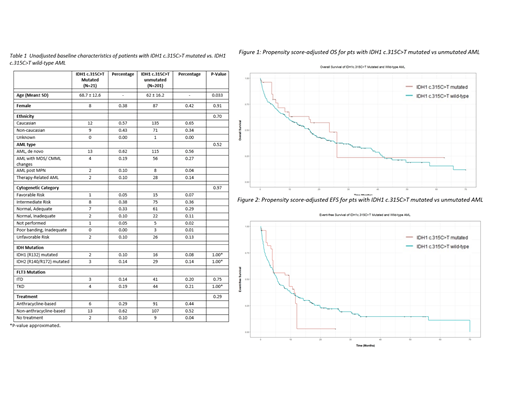Abstract
Introduction
Mutations have become essential in determining risk stratification for acute myeloid leukemia (AML) and are often used to guide treatment. Variants of unknown significance (VUS) can be classified as pathogenic or benign once their roles are better understood. Therefore, studying VUS in mutated genes may improve overall risk stratification and prognostication for AML patients.
Mutations in isocitrate dehydrogenases, IDH1 or IDH2, occur in approximately 20% of AML. R132 (in IDH1) and R140/R172 (in IDH2) mutations lead to the production of oncometabolite 2-hydroxyglutarate and have been targeted with selective oral inhibitors; however, the clinical impact of the synonymous single nucleotide polymorphism (SNP) in codon 105 in exon 4 of the IDH1 gene (c.315C>T (p.Gly105Gly), s11554137) is poorly understood. This VUS is not commonly screened for in myeloid mutation panels. Here, we aimed to investigate the prognostic significance of the c.315C>T SNP in AML patients.
Methods
We conducted a single-site retrospective study to compare overall survival (OS), event-free survival (EFS), complete remission (CR) and complete remission with incomplete hematologic recovery (CRi) rates in adults with AML with and without the IDH1:c.315C>T (p.Gly105=) between 2013 and 2020. The IDH1 c.315C>T SNP was identified using Sanger's technique. Data collected included age, gender, ethnicity, ECOG performance status, baseline comorbidities, AML category, cytogenetics, myeloid mutations including IDH1/IDH2/FLT3, treatments received, and survival outcomes. Data were analyzed using propensity score-weighting to obtain adjusted estimands. CR+CRi rates in patients with and without c.315C>T IDH1 mutation were compared using Fisher's exact test or Chi-square test. Survival outcomes were compared using the Gehan-Breslow-Wilcoxon rank test and adjusted Cox proportional hazards regression.
Results
We included 228 patients (median age 65.2 years [IQR: 54-75]). The IDH1 c.315C>T SNP was identified in 21 (9%) patients. Table 1 shows unadjusted baseline characteristics. The presence of IDH1 c.315C>T SNP was not mutually exclusive with conventional IDH mutations. The CR+CRi adjusted rates were 60% and 51% with first-line treatment in patients with and without the mutation (P=0.42). The adjusted-median OS was 26.1 (95 CI: 9.8-NA) and 17 (95 CI: 12.6-21.8) months (P=0.69). The adjusted hazard ratio for mortality was 1.4 higher in the unmutated category (95 CI: 0.997-1.98, P=0.05). The adjusted-median EFS was 9.53 (95 CI: 4.17-NA) and 5.57 (95 CI: 4.43-7.87) months (P=0.89). The adjusted hazard ratio for mortality or relapse was 1.1 higher in the unmutated category (95 CI: 0.81-1.47, P=0.56). Figures 1 and 2 show OS and EFS survival curves.
Conclusions
Unlike in previous studies, the presence of IDH1 c.315C>T SNP was not associated with inferior OS, PFS or CR+CRi rates compared with its absence.
Emadi: Secura Bio.: Consultancy; Servier: Membership on an entity's Board of Directors or advisory committees; Amgen: Membership on an entity's Board of Directors or advisory committees; Servier: Research Funding; NewLink Genetics: Research Funding; Jazz Pharmaceuticals: Research Funding; KinaRx, Inc.: Membership on an entity's Board of Directors or advisory committees, Other: Co-founder.


This feature is available to Subscribers Only
Sign In or Create an Account Close Modal